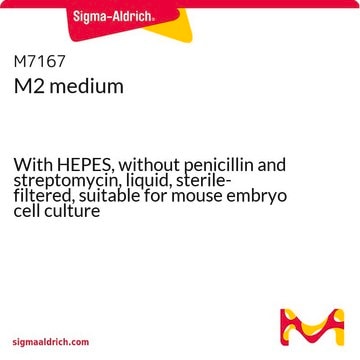SCR012
PluriStem 129/S6 Murine ES cells
The PluriStem 129S6 Murine ES cell line is derived from the widely used 129/S6/SvEv strain of mice (at 3.5 days p.c.) & is intended for injection into black or albino host blastocysts.
Sign Into View Organizational & Contract Pricing
All Photos(1)
About This Item
UNSPSC Code:
41106509
eCl@ss:
32011203
NACRES:
NA.81
Recommended Products
biological source
mouse
Quality Level
manufacturer/tradename
Chemicon®
PluriSTEM®
technique(s)
cell culture | stem cell: suitable
input
sample type: mouse embryonic stem cell(s)
shipped in
liquid nitrogen
General description
The PluriStem 129S6 Murine ES cell line is derived from the widely used 129/S6/SvEv strain of mice (at 3.5 days p.c.) and is intended for injection into black or albino host blastocysts. This cell line is characterized by the production of highly chimeric, germline-competent mice. Cells are supplied at passage 10.
Complete disease testing and karyotype data is available under Information Library tool bar, Tech Notes at SCR012 product specific page at http://www.chemicon.com/Product/ProductDataSheet.asp?ProductItem=SCR012.
STRAIN: 129/S6/SvEv
GENDER: Male
KARYOTYPE: 40XY
Complete disease testing and karyotype data is available under Information Library tool bar, Tech Notes at SCR012 product specific page at http://www.chemicon.com/Product/ProductDataSheet.asp?ProductItem=SCR012.
STRAIN: 129/S6/SvEv
GENDER: Male
KARYOTYPE: 40XY
Cell Line Description
Embryonic Stem Cells
Application
Research Category
Stem Cell Research
Stem Cell Research
Packaging
2.5 x 106 cells per vial
Physical form
Cells are supplied frozen in basal medium supplemented with 10% FCS and 10% DMSO
Storage and Stability
Place vials in liquid Nitrogen immediately upon receipt until it is convenient to proceed to subculture.
Legal Information
CHEMICON is a registered trademark of Merck KGaA, Darmstadt, Germany
PLURISTEM is a registered trademark of Merck KGaA, Darmstadt, Germany
Disclaimer
Unless otherwise stated in our catalog or other company documentation accompanying the product(s), our products are intended for research use only and are not to be used for any other purpose, which includes but is not limited to, unauthorized commercial uses, in vitro diagnostic uses, ex vivo or in vivo therapeutic uses or any type of consumption or application to humans or animals.
Storage Class Code
12 - Non Combustible Liquids
WGK
WGK 1
Flash Point(F)
does not flash
Flash Point(C)
does not flash
Certificates of Analysis (COA)
Search for Certificates of Analysis (COA) by entering the products Lot/Batch Number. Lot and Batch Numbers can be found on a product’s label following the words ‘Lot’ or ‘Batch’.
Already Own This Product?
Find documentation for the products that you have recently purchased in the Document Library.
Ruilin Sun et al.
Nucleic acids research, 40(21), e166-e166 (2012-08-11)
Methods for generating loss-of-function mutations, such as conventional or conditional gene knockout, are widely used in deciphering gene function in vivo. By contrast, inducible and reversible regulation of endogenous gene expression has not been well established. Using a mouse model
Tao Deng et al.
Development, growth & differentiation, 49(7), 603-610 (2007-07-20)
The completely embryonic stem (ES) cell-derived mice (ES mice) produced by tetraploid embryo complementation provide us with a rapid and powerful approach for functional genome analysis. However, inbred ES cell lines often fail to generate ES mice. The genome of
Ting Li et al.
Oncotarget, 6(31), 31805-31819 (2015-09-18)
Activation of IκB kinase β (IKK-β) and nuclear factor (NF)-κB signaling contributes to cancer pathogenesis and inflammatory disease; therefore, the IKK-β-NF-κB signaling pathway is a potential therapeutic target. Current drug design strategies focus on blocking NF-κB signaling by binding to
Babita Madan et al.
Molecular and cellular biology, 29(11), 3186-3203 (2009-04-01)
Dppa4 (developmental pluripotency-associated 4) has been identified in several high-profile screens as a gene that is expressed exclusively in pluripotent cells. It encodes a nuclear protein with an SAP-like domain and appears to be associated preferentially with transcriptionally active chromatin.
Yang Gao et al.
Journal of neurochemistry, 134(2), 340-353 (2015-04-16)
Glutamate carboxypeptidase II (GCPII) is a transmembrane zinc metallopeptidase found mainly in the nervous system, prostate and small intestine. In the nervous system, glia-bound GCPII mediates the hydrolysis of the neurotransmitter N-acetylaspartylglutamate (NAAG) into glutamate and N-acetylaspartate. Inhibition of GCPII
Protocols
This page covers the indirect co-culture of embryonic stem cells with embryonic fibroblasts.
Our team of scientists has experience in all areas of research including Life Science, Material Science, Chemical Synthesis, Chromatography, Analytical and many others.
Contact Technical Service








